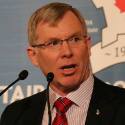Within National Defence and the Canadian Armed Forces, the concepts of capability and operational readiness are well understood and part of a robust debate informing the future force.
In a recent presentation to the Conference of Defence Associations Institute, LGen (Ret’d) Stu Beare, the former commander of Canadian Joint Operations Command, outlined a series of functions that are less well recognized, functions that promote prevention, enable deterrence, inform strategic decision-making, deliver operational deployment and employment, and set the conditions for mission success. He called these functions “mission preparedness.”
He asked serving and retired military members and senior public executives to assess where the investment in these vital functions is going as military budgets shrink and Defence institutions face growing challenges around resource allocation and procurement to meet commitments and requirements.
In a world of increasing instability, volatility and uncertainty, and where the frequency and concurrency of events will endure, how should we be investing in: understanding; planning and preparation; practising, mission rehearsal; and in the partnerships and relationships that enable all of these?
These are fundamental functions of mission preparedness and they are complementary to, and essential for, the effective use of the Canadian Armed Forces, our capabilities and our operational readiness.
They merit a focus and investment across and beyond the Forces. There are real jobs to be done and conditions to be set before we commit armed forces and security partners into future operational missions.
Understanding the security environment requires work. Anticipating future crisis and challenges is our responsibility, and must be done with international and inter-agency partners.
To be prepared to solve – or avoid – the crises, threats and challenges of tomorrow, it is vital that we:
• Partner, plan and practice with allies and other agencies to be responsive and effective, setting the conditions for speed, relevance, and effectiveness.
• Posture the force to be effective where and when required in areas such as communications; intelligence and surveillance; logistics, access, basing, and over-flight; lines of communications across maritime, air and land; and operational sustainment, at home and in the countries where we are guests.
• Preserve and exploit our use of the global commons, including space and cyber, ensuring the networks, communications and information systems stay connected to allow us to understand, partner, plan, posture, and practice.
• Fight to build the picture, sustain and protect the networks, and preserve our own exploitation and use of the space and cyber domains.
• And, finally, manage the concurrency of all these things across all domains – maritime, air, land, space, cyber, and information – and all geographies.
Despite the obvious demand for mission preparedness, are we seeing real investment within the Defence institution in functions such as structure, capacity, systems and best practices? Or in mission preparedness activities such as interagency partnering, planning, training and exercising, and in relationship building? Where is that investment going?
In structure, what do we see as overhead – tail versus tooth – by resource managers and by central agencies? And in resourcing, what do we see as discretionary or residual versus baseline and necessary?
Within the Force, who is charged with, and how operationally focused are we, on fighting for the information, commanding sensors, collaborating with partners, and fusing the picture across institutions and partnerships at all levels, from tactical to operational, to strategic?
Who commands the Force’s network operations, assuring the integrity of the network, building, adapting and protecting our information and connecting it with partners, while assuring our integration and interoperability before crises happens?
Who commands in the space domain, including our partnerships and efforts in the exploitation and preservation of space capability and capacity?
Where, with whom, and how do we set conditions for preparedness across national security institutions and with traditional and non‐traditional partners? With whom do we partner, plan, and practice?
What is the understanding and attitude of the profession, the institution and the central agencies about the structure and resources required to do all these things? Is this expression of “mission preparedness” – its functions, structures, processes, partnerships and best practices – taught and universally understood by those in uniform? And do those functions have a home in doctrine, training and education and in the long-term capability plan for the Force?
The answer? Yes, to an extent.
I know most of these are in play within the profession and the defence institution, but they don’t enjoy the same understanding, interest or demand for resourcing as our equally vital but far more visible capabilities and operational readiness.
Making sense of all of this – determining real resource requirements and making best use of those available – isn’t a homework assignment for National Defence and the Canadian Armed Forces. Focusing and managing the massive array and concurrency of security challenges today is easier to do when it is informed by a national security strategy.
Normalizing “mission preparedness” alongside general purpose combat capability and operational readiness requires a defence policy that accounts for all of them, and has stable and predictable funding to enable all of them.
Steering these through an increasing dynamic and unpredictable international and national security environment and dealing with surprise requires a persistent and engaged framework for national security, intelligence, planning and operations that connects our institutions at home and that allows those institutions to foster and make best advantage of key international partnerships abroad.
Competitors, adversaries, and enemies – and Mother Nature – don’t care what our institutional capability, readiness and preparedness challenges are. But assuring our understanding, relevance, effectiveness, and readiness for the defence of Canada and Canadians today – and our posture and preparedness for the future – requires that we do.
This article was adapted from a presentation to CDAI and will be developed into an upcoming paper for the Canadian Defence and Foreign Affairs Institute, where LGen Beare is a Research Fellow.

